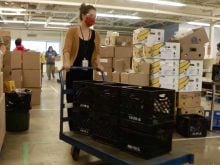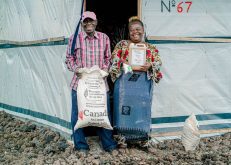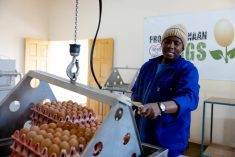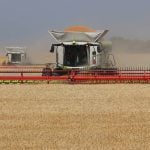Hunger among people in Somalia is rampant after years of drought and conflict, and the care offered by relief groups is life-saving, according to a Canadian Foodgrains Bank staff member who is fresh off a trip to the region.
“It’s absolutely critical that we can provide this kind of support in this setting,” said Stefan Epp-Koop, humanitarian and program manager with the charity.
Why it matters: The Canadian Foodgrains Bank has observed disheartening circumstances in the Horn of Africa due to local conflict, drought and geopolitical impacts from the war in Ukraine.
Read Also

MANITOBA AG DAYS 2026: Stacked equipment category expected at Innovation Showcase
Ten of 28 Innovation Showcase entries at the Manitoba Ag Days 2026 farm show Jan. 20-22 in Brandon are in the equipment category.
Epp-Koop spent 12 days in Eastern Africa this spring, including visits to aid programs run by a partner organization, Trocaire, in Somalia. The nation on the Horn of Africa is mired in conflict between Islamic insurgency group Al-Shabaab and the Somali government, which has only tenuous control on parts of the country, he said.
Terrorist attacks by Al-Shabaab and clashes between insurgents and troops have killed and injured civilians and displaced citizens from their homes, a November 2022 report from the UN said.
During a Feb. 22 meeting of the UN Security Council, the UN’s deputy special representative of the secretary-general for Somalia, Anita Kiki Gbeho, described last year as the deadliest for civilians since 2017. About 185,000 people were displaced by recent conflicts and at least 63 civilians were killed, she reported at that time.
Theft of herds, property and assets, forced recruitment and sexual violence have also caused suffering and displacement, Epp-Koop said.
Meanwhile, almost half of Somalia’s population—8.3 million people—would likely need humanitarian aid this year, Gbeno said in the same February meeting. She indicated that famine risk was still present if drought continued or aid levels dropped.
Somalia has suffered from five failed rainy seasons since 2020, which has decimated livestock herds in the largely pastoral country.
The cumulative impact of those failures has led to “catastrophic” food insecurity, the UN reported in December 2022.
In the town of Luuq, Epp-Koop met Muslima, a 20-year-old Somali woman who had brought her two-year-old son, Ducale, to a hospital for ongoing treatment of severe malnourishment. Muslima first brought Ducale to Trocaire’s nutrition program in February after recognizing the signs of malnourishment, Epp-Koop said.
“He’s improved significantly over the time that he’s been in treatment,” he said.
Months later, Muslima continues to bring Ducale to the hospital every two weeks for checkups, and to receive a two-week supply of nutritional supplements.
Small children are most likely to suffer from severe malnutrition, Epp-Koop said, and Trocaire’s programming focuses on this demographic, as well as pregnant and nursing women. It also services camps of displaced people to ensure they get health care and that children receive treatment for malnutrition as soon as possible.
Trocaire has seen a surge in need for emergency nutrition for kids like Ducale. A visit to the hospital in Luuq revealed 25 patients in the ward for severely malnourished children, Epp-Koop said. There were only 15 beds.
“There’s huge demand…that demand is not going down.”
Canadian Foodgrains Bank partners are distributing cash that allows people to buy food. However, food prices have risen drastically with combined factors like rising energy costs, the war in Ukraine and localized conflict and drought.
This will be a year of tremendous need, Epp-Koop said, but he noted that Trocaire workers also see opportunity to build more resilient livelihoods for Somalians.
Tighter belts
The Canadian Foodgrains Bank, along with other relief charities, expressed dismay after the Canadian government cut its budget for international assistance funding in 2023.
At the end of March, a group of more than 100 such organizations released a statement that said the aid budget had been cut by $1.3 billion, or 15 per cent.
“At a time when global needs are growing significantly, Canada’s ODA percentage [official development assistance] now sits at the lowest for decades,” said Andy Harrington, Canadian Foodgrains Bank executive director.
In the short term, the foodgrains bank doesn’t expect a reduction in available funds for programming, Epp-Koop said, and although the Canadian government continues to be a major supporter of the organization, cuts are a step in the wrong direction.
In its statement, the coalition of charities said it was hopeful the federal government would announce more funding later this year.
















